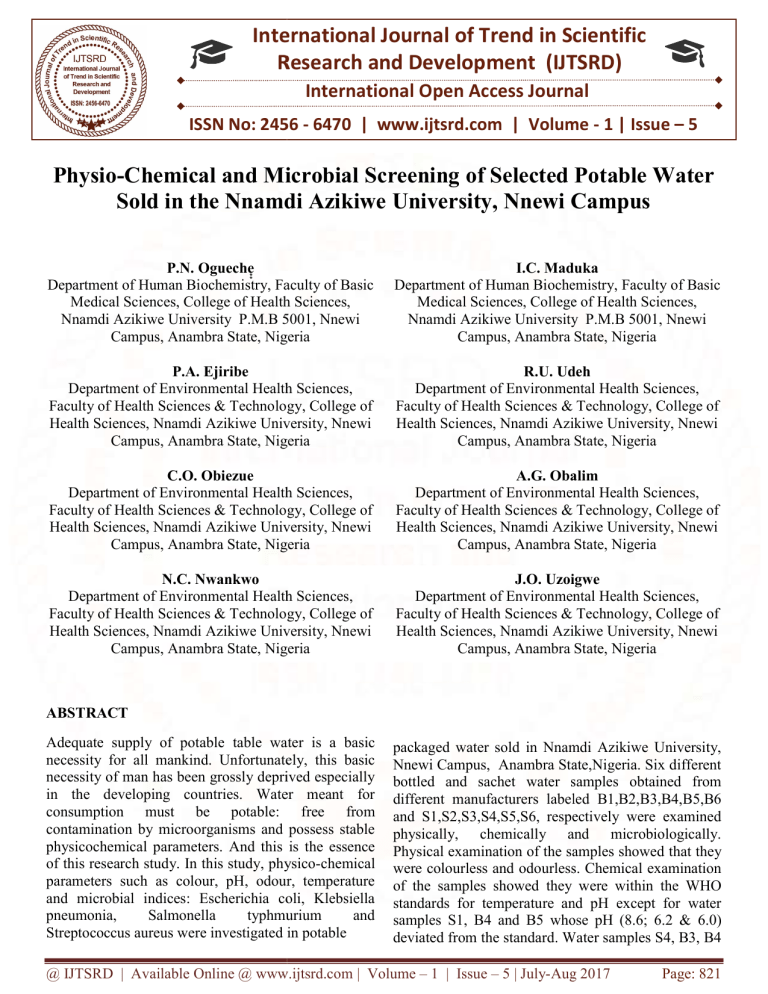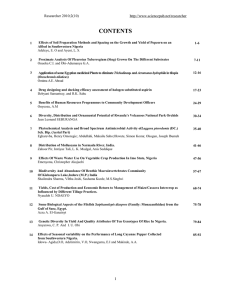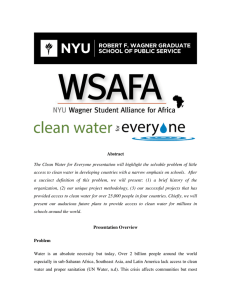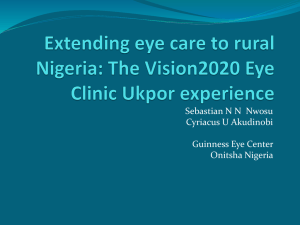
International Journal of Trend in Scientific
Research and Development (IJTSRD)
International Open Access Journal
ISSN No: 2456 - 6470 | www.ijtsrd.com | Volume - 1 | Issue – 5
Physio-Chemical
Chemical and Microbial Screening of Selected Potable Water
Sold in the Nnamdi Azikiwe University, Nnewi Campus
P.N. Ogueche͙͙
Department of Human Biochemistry, Faculty of Basic
Medical Sciences, College of Health Sciences,
Nnamdi Azikiwe University P.M.B 5001, Nnewi
Campus, Anambra State, Nigeria
I.C. Maduka
Department of Human Biochemistry, Faculty of Basic
Medical Sciences, College of Health Sciences,
Nnamdi Azikiwe University P.M.B 5001, Nnewi
Campus, Anambra State, Nigeria
P.A. Ejiribe
Department of Environmental Health Sciences,
Faculty of Health Sciences & Technology,
logy, College of
Health Sciences, Nnamdi Azikiwe University, Nnewi
Campus, Anambra State, Nigeria
R.U. Udeh
Department of Environmental Health Sciences,
Faculty of Health Sciences & Technology,
Te
College of
Health Sciences, Nnamdi Azikiwe University, Nnewi
Campus, Anambra State, Nigeria
C.O. Obiezue
Department of Environmental Health Sciences,
Faculty of Health Sciences & Technology,
hnology, College of
Health Sciences, Nnamdi Azikiwe University, Nnewi
Campus, Anambra State, Nigeria
A.G. Obalim
Department of Environmental Health Sciences,
Faculty of Health Sciences & Technology,
Te
College of
Health Sciences, Nnamdi Azikiwe University, Nnewi
Campus, Anambra State, Nigeria
N.C. Nwankwo
Department of Environmental
ntal Health Sciences,
Faculty of Health Sciences & Technology,
hnology, College of
Health Sciences, Nnamdi Azikiwe University, Nnewi
Campus, Anambra State, Nigeria
J.O. Uzoigwe
Department of Environmental Health Sciences,
Faculty of Health Sciences & Technology, College of
Health Sciences, Nnamdi Azikiwe University, Nnewi
Campus, Anambra State, Nigeria
ABSTRACT
Adequate supply of potable table water is a basic
necessity for all mankind. Unfortunately, this basic
necessity of man has been grossly deprived especially
in the developing countries. Water meant for
consumption must be potable:: free from
contamination
mination by microorganisms and possess stable
physicochemical parameters. And this is the essence
of this research study. In this study, physico
physico-chemical
parameters such as colour, pH, odour, temperature
and microbial indices: Escherichia coli, Klebsiella
pneumonia,
Salmonella
typhmurium
and
Streptococcus aureus were investigated in potable
packaged water sold in Nnamdi Azikiwe University,
Nnewi Campus, Anambra State,Nigeria. Six different
bottled and sachet water samples obtained from
different manufacturers
turers labeled B1,B2,B3,B4,B5,B6
and S1,S2,S3,S4,S5,S6, respectively were examined
physically, chemically and microbiologically.
Physical examination of the samples showed that they
were colourless and odourless. Chemical examination
of the samples showed they were within the WHO
standards for temperature and pH except for water
samples S1, B4 and B5 whose pH (8.6; 6.2 & 6.0)
deviated from the standard.. Water samples S4, B3, B4
@ IJTSRD | Available Online @ www.ijtsrd.com | Volume – 1 | Issue – 5 | July-Aug
Aug 2017
Page: 821
International Journal of Trend in Scientific Research and Development (IJTSRD) ISSN: 2456-6470
and B5 indicated presence of E. coli where as S6
indicated presence of Klebsiella pneumoiae.
Streptococcus aureus was present in B3. From our
study, its suggestive that the packaged water analyzed
were not chemically and microbiological fit for
consumption though this need to be further
investigated.
Key words: Potable water, Escherichia coli, Klebsiella
pneumonia and Salmonella typhmurium and
Streptococcus aureus.
INTRODUCTION
Adequate supply of potable table water is a basic
necessity for all mankind. Unfortunately, this basic
necessity of man has been compromised and
neglected over the decades by successive government
administrations at the expense of quality life. In many
developing countries, availability of potable water has
become a critical and urgent problem hence a matter
of concern to families and communities (Adekunle et
al., 2004). Water is an essential part of human
nutrition and is required for maintenance of personal
hygiene, food production and prevention of diseases
(Thliza et al., 2015). It is the most abundant substance
in nature and occupies about 70% of the earth’s crust
(Anyamene and Ojiagu, 2014; Thliza et al., 2015).
Water is a biological medium which exists as solid,
liquid
and
gas
(Thliza
et
al.,
2015).
Colourless,odourless and tasteless water is vital for all
known live forms. It’s the major constituent of the
fluid of organisms. In a recent estimate based on
WHO reports suggests that 80% of all human illnesses
in the developing world are caused by biological
contamination (WHO, 2008). The majority of the
population in developing countries is not adequately
supplied with potable water, and thus obliged to use
unsafe water for domestic purposes. (Ajayi, et al.,
2008). Water should be clear, without disagreeable
taste, color or odour for it to be deemed fit for human
and animal consumption. If otherwise, then it needs to
be treated, cleaned or filtered to meet established
drinking standards (Aroh et al., 2013; Isikwue and
Chikezie, 2014). Water can be sourced from surface
such as river, streams or ground such as spring, well
and borehole (Aroh et al., 2013). Agencies that
regulate water quality worldwide is the World Health
Organization (WHO). They determine standards and
guidelines for water quality (WHO, 2001 and 2002).
So as to ensure the highest quality of potable water in
order to safe guard public health (Anunobi et al.,
2006; Isikwue and Chikezie, 2014).
There are various water treatment processes, the
major procedures are aeration, coagulation,
flocculation, sedimentation, slow sand filtration, rapid
filtration and disinfection (Ibemesim, 2014).
To minimize the risk of bacterial growth in drinking
water, (WHO, 2004) reported that chlorination,
ozoniation, ultra violet radiation and advanced
oxidation processes are widely accepted for
disinfection of drinking water.
Unsafe water is a global public health threat, placing
persons at risk for a host of diarrhea and other
diseases as well as chemical intoxication (Ashaye,
2001). The exposure to this microbial contaminant
can lead to microbial infections like cholera, typhoid
fever and dysentery. Varieties of microorganisms are
water borne and due to this fact, conformation with
microbiological standard is of special interest because
of the capacity of water to spread diseases within a
large population (Omezuruike et al., 2008). Whenever
water is submitted for testing, it will also be analyzed
for the bacteriological property. Microbial character
of bottled and sachet potable water can be influenced
by certain factors like handling, treatment and expiry.
Packaged water is one of the main sources of water
supply in most Nigerian institutions and since it is
used for human consumption, it should meet required
microbial standards. Hence, microbial analysis of
packaged water sold at tertiary institutions must be
carried out to monitor the effectiveness of treatment
process. And this is the essence of this research. To
determine presence of pathogenic microorganisms
such as E. coli, Klebsiella pneumoniae, Salmonella
typhmurium and Streptococcus aureus in potable table
water (sachet and bottled) sold in the Nnamdi
Azikiwe University, Nnewi Campus, Anambra State,
Nigeria.
MATERIALS AND METHOD
The materials used in this research work
were
sachet and bottled water, bought from vendors located
within the Nnewi Campus, of Nnamdi Azikiwe
University, Anambra State, Nigeria. The water
samples were produced from six different
manufacturers labeled S1 – S6 and B1 – B6. The
letters S and B indicate sachet and bottled water
respectively. The names of these manufactures of the
table water were withheld and labeled with letters in
accordance with best practices.
@ IJTSRD | Available Online @ www.ijtsrd.com | Volume – 1 | Issue – 5 | July-Aug 2017
Page: 822
International Journal of Trend in Scientific Research and Development (IJTSRD) ISSN: 2456-6470
The physical properties of the table water used in this
study were visually determined, however the chemical
property (pH) were determined using pH meter. The
pH meter was standardized using phosphate buffer of
pH 7.0. Microbial screenings were carried out using
standard microbiological methods by the method of
US Environmental Protection Agencies 2002 and
Hanaor and Sorrelli 2004.
BACTERIOLOGICAL WATER ANALYSIS
The water sample was first mixed properly, about
50µl of water sample was aseptically collected
directly from each of the water containers using a
sterile wire loop, it was cultured on two neutral agar
media. One set of the agar was incubated at room
temperature, 250C and the other at 370C for 48hours in
an incubator. At the end of this incubation, the agar
media were visually examined for bacterial growth,
count and cultural characteristics. Bacterial colony
forming units (CFU) of 30 and above were considered
significant growth. Grams stain and cultural
characteristics on the selective medium were used to
identify the cultured bacterial organisms.
RESULTS AND DISCUSSION
From table 1.0, the sachet water samples were
colourless and odourless, and were within the WHO
standard. It was observed that the water temperature
fell within the WHO acceptable level. Chemical
examinations (pH) of the sachet water samples: S2,
S3, S4, S5 and S6 were within the WHO acceptable
range while the pH of water samples S1 fell outside
the WHO acceptable range. In table 2.0, the bottled
water samples were colourless and odourless, and
were within the WHO standard. It was observed that
the water temperature of the six different bottled
water samples had a constant value of 290C and that
was within the range of WHO acceptable level. The
pH of bottled water samples: B1, B2, B3, and B6 had
the WHO acceptable range whereas the B4 and B5
had values slightly acidic, which were outside the
WHO limit. In table 3.0, sachet water samples: S4 and
S6 indicated presence of Klebsiella pneumoiae and E.
coli respectively while S1,S2,S3 and S5 showed
absence of microorganism under study. In water
samples B3,B4 and B5 indicated presence of E. coli
while
B1,B2, and B6 indicated absence of
microorganism under study. In addition, streptococcus
aureus is present in B3 and its not seen in any other
bottled water samples.
Discussion:
In human cultural evolution, the importance of water
cannot be overemphasized, such that settlement was
preferred along areas where there were water sources
(streams and rivers). This is to depict that adequate
supply of potable table water is a basic necessity for
all mankind. Unfortunately, this basic necessity of
man has been compromised and neglected over the
decades by successive government administrations at
the expense of quality life. In many developing
countries of the world, drastic potable water scarcity
has become critical and compulsory threat to all life
forms especially the human beings. It has been
reported that drinking of unhygienic water in poor
countries has resulted in the death of 2.2 million
people per annum, 99 percent of these are children
under the age five (WHO, 2004). This threat of water
scarcity demand declaration of state of emergency to
any sensible government. Water meant for
consumption must be potable: free from
contamination by microorganisms and possess stable
physiochemical parameters.
In tables 1.0 and 2.0, the water samples under study
had temperatures with the acceptable WHO range.
This indicates that the potable water samples had
stable room temperatures. Similarly, the colour and
odour of the water samples showed that all water
samples were colourless and odourless respectively,
thus within the WHO requirement (not objectionable)
. The water samples under study can be described as
being attractive and may account for its patronage by
the inhabitants of the study area. Our observation is in
line with works done by Anyaeze et al.,2013 and
Maduka et al., 2014. World Health Organization
recommended that potable water for consumption
should not contain any microorganism known to be
pathogenic (WHO, 1984). From our results, the sachet
water samples (S4 and S6) indicated presence of
Klebsiella pneumoniae and E. coli respectively where
as the bottled water samples (B3, B4 and B5)
indicated presence of E. coli. The presence of E coli
in a water sample according to reports of Adekunle et
al., 2004, and Edema et al., 2001 is an indication of
water pollution. This is because the presence of E.
coli is most often accompanied by the presence of
dangerous enteric pathogens like Shigella, Salmonella
and Campylobacter species (Shilklomanov, 2000 and
Edberg et al., 2000). However, streptococcus aureus
was present in one of the bottled water samples
labeled B3. The microorganism under study such as
Salmonella typhmurium was absent in all the water
@ IJTSRD | Available Online @ www.ijtsrd.com | Volume – 1 | Issue – 5 | July-Aug 2017
Page: 823
International Journal of Trend in Scientific Research and Development (IJTSRD) ISSN: 2456-6470
(sachet and bottled) samples analyzed. The absence of
S.typhmurium in all the water samples suggests that
the water samples under study is free such organism
and its attendant disease causing effects specifically
typhoid fever. In two separate studies of Maduka et
al.,2014 and Tortora et al., 2002 absence of
S.typhmurium in a water samples suggests that
typhoid fever may not be contacted from the water
samples. The bacteriological quality of drinking water
is of immense importance because several studies
have attributed several disease outbreaks to untreated
or poorly treated water containing bacteria pathogens
that have been isolated from sachet water (Shear et
al., 1995).
CONCLUSION
The presence of microorganisms: E. coli, Klebsiella
pneumoniae, and Streptococcus
aureus as well
deviation in the physio-chemical properties of
potable packaged table water (sachet and bottled) sold
in one of the Nigerian Tertiary Institutions have been
established in this study. The contamination could be
as a result of unhygienic acquisition of water source,
poor handling, processing and after production
effects especially expiration. Water with high acidity
or alkalinity as well the bacteria enumerated above (E.
coli, Klebsiella pneumoniae, and Streptococcus
aureus) is not safe or potable for human consumption,
hence, water vended for public consumption need to
be re-examined. And relevant agencies saddled with
the responsibility of regulating standards in quality
water production such as the National Agency for
Food & Drug Administration Control (NAFDAC) and
World Health Organisation (WHO) should be alive
and dutiful.
Table 1.0 Physicochemical Properties of the Potable Satchet Water
Physical/
chemical
parameters
Colour
pH
Temperature
Odour
S1
S2
S3
S4
S5
S6
Colourless Colourless
Colourless
Colourless
Colourless
Colourless
WHO
ACCEPTABLE
RANGE
Colourless
8.6
29
Odourless
7.9
30
Odourless
7.6
29
Odourless
7.7
29
Odourless
7.8
28
Odourless
6.5-8.5
20-30
Unobjectionable
8.1
30
Odourless
Table 2.0 Physicochemical Properties of the Potable Bottled Water
Physical/chemica
l parameters
B1
B2
B3
B4
B5
B6
Colour
Colourless
Colourless
Colourless
Colourless
Colourless
Colourless
Colourless
pH
7.4
7.0
7.1
6.2
6.0
6.8
6.5-8.5
Temperature
(oC)
29
29
29
29
29
29
20-30
Odour
Odourless
Odourless
Odourless
Odourless
Odourless
Odourless
Unobjectionable
@ IJTSRD | Available Online @ www.ijtsrd.com | Volume – 1 | Issue – 5 | July-Aug 2017
WHO
ACCEPTABLE
RANGE
Page: 824
International Journal of Trend in Scientific Research and Development (IJTSRD) ISSN: 2456-6470
Table 3.0 Microbial Screening of the Potable SATCHET Water
Microorganisms
Escherichia coli
Klebsiella pneumonia
Salmonella typhmurium
Staphylococcus aureus
Streptococcus faecalis
S1
S2
S3
S4
S5
S6
+
+ means presence of microbial contamination by one of the organisms under study.
- means absence of microbial contamination by one of the organisms under study
+
-
Table 4.0 Microbial Screening of the Potable Bottled Water
Microorganisms
Escherichia Coli
Klebsiella Pneumoniae
Salmonella
Typhmurium
Staphylococcus Aureus
Streptococcus Faecalis
B1
-
B2
-
B3
+
-
B4
+
-
B5
+
-
+
+ means presence of microbial contamination by one of the organisms under study.
- means absence of microbial contamination by one of the organisms under study
REFERENCES
1) Adegoke, O.O., Bamigbowu, E.O., Oni, E.S. and
Ugbaja,
K.N.
(2012).
Microbiological
examination of sachet water sold in Nnewi,
Anambra State, Nigeria. Global Research Journal
of Microbiology 2: 62-66.
2) Adekunle, L.V., Sridhar,M.K.C., Ajayi, A.A.,
Oluwude, P.A. and Olawuyi J.F.(2004). An
assessment of the health and social economic
implications of sachet water in Ibadan,Nigeria: A
public health challenge. African Jounal
Biomedical Research. 7:5-8.
3) Adetunde, L.A., Sackey, I., Elvis, B.B. and
Afarawoye, A.E. (2014). Bacteriological quality
of sachet water produced and sold in the
Bolgatanga Municipal in the Upper East Region
of Ghana. International Journal of Modern Social
Sciences 3: 36-43.
4) Ajewole, I.A. (2005). Water an Overview, Food
Forum, A Publication of the Nigerian Institute of
Food Science and Technology, September 2005,
4(1):15.
5) Akinde, S.B., Nwachukwu, M.I. and Ogamba,
A.S. (2011). Storage effects on the quality of
sachet water produced within Port Harcourt
B6
-
metropolis, Nigeria. Journal of Biological
Sciences 4: 157-164.
6) Anuobi, C.C., Onajole, A.T. and Ogunnowo, B.E.
(2006). Assessment of the quality of packaged
water on sale in Onitsha metropolis. Nigerian
Quarterly Journal of Hospital Medicine 16: 5659.
7) Anyamene, N.C. and Ojiagu, D.K. (2014).
Bacteriological Analysis of sachet water sold in
Akwa Metropolis, Nigeria. International Journal
of Agriculture and Biosciences 3: 120-122.
8) Aroh, K.N., Eze, E.M., Ukaji, D., Wachuku, C.K.,
Gobo, A.E., Abbe, S.D., Teme, S.C. and Igoni,
A.H. (2013). Health and environmental
components of sachet water consumption and
trade in Aba and Port Harcourt, Nigeria. Journal
of Chemical Engineering and Material Science 4:
13-22.
9) Backer and Howard, (2002). Water disinfection
for International and wilderness travelers. clinical
infectious disinfection. 34(3):335-364.
10) Banu, N. and Menakuru, H. (2010). Enumeration
of microbial contaminants in sachet water: A
public health challenge. Health 6: 582-588.
@ IJTSRD | Available Online @ www.ijtsrd.com | Volume – 1 | Issue – 5 | July-Aug 2017
Page: 825
International Journal of Trend in Scientific Research and Development (IJTSRD) ISSN: 2456-6470
11) CDC, (2007). Guidelines for isolation precautions:
preventing transmission of infectious Agent in
Healthcare settings.
12) Danso-Boateng, E. and Frimpong, I.K. (2013).
Quality analysis of plastic sachet and bottled
water brands produced or sold in Kumasi, Ghana.
International Journal of Development and
Sustainability 4: 2222-2232.
13) Diersing, N. (2009). Water quality: Frenquently
asked questions. PDA NOAA. Available at http://
floridakeyr.noaa.gov / pdf / wqfaq.pdf. Accessed;
13th July, 2015.
14) Edberg, S.C., Rice, E.W., Kar, R.J. and Allen,
M.J. (2000). Escherichia coli. The best biological
water indicator for public health protection. J.
App. Microbial. 88:1068-1168.
15) Edema, M.O., Omemu, A.M. and Fapetu, O.M.
(2001). Microbiology and Physico- Chemical
Analysis of Different Sources of Drinking Water
in Abeokuta, Nigeria. Niger, J. Microbiology.;
15(1):57– 61.
16) Hanaor, D.A.H. and Sorrelli (.C. 2004). Sand
supported mixed-phase. T1O2 photocatalyst for
water determination applications. Advanced
Engineering materials; 16(2):248 – 257.
17) Hughes, J.M. and Koplan, J.P. (2005). Saving
lives through global safe water. Journal of
Infectious Diseases 11: 1636- 1637.
18) Ibemesim, A.O. (2014). Comparative study of
qualities of sachet and bottle water sold on the
streets of Abuja, Nigeria. South American
Journal of Public Health 2: 308-328.
19) Isikwue, M.O. and Chikezie, A. (2014). Quality
assessment of various sachet water brands
marketed in Bauchi metropolis of Nigeria.
International Journal of Advances in
Engineering and Technology 6: 2489-2495.
20) Johnson, D.L., Ambrose, S.H., Bassett, T.J.,
Bowen, M.L., Crummey, D.E., Isaacson, J.S.,
Johnson, D.N., Lamb, P., Saul, M. and WinterNelson, A.E. (1997). Meaning of environmental
terms. Journal of Environmental Quality 20:
581-589.
21) Kleiner, S.M. (1999). Water: An Essential but
Overlooked Nutrient. J. Am. Diet. Association.;
99:200 – 206.
22) Maduka, H.C.C., Chukwu, N.C., Ugwu, C.E.,
Dike, C.C., Okpogba, A.N., Ogueche, P.N. and
Maduka, A.A. (2014). Assessment of
commercial bottled table and sachet water
commonly consumed in Federal University of
Technology, Owerri (FUTO), Imo State,
23)
24)
25)
26)
27)
28)
29)
30)
31)
32)
33)
Nigeria using Microbiological indices. Journal
of Dental and Medical Sciences 13: 86-89.
Nwosu, J.N. and Ogueke, C.C. (2004).
Evaluation of sachet water samples in Owerri
metropolis. Nigeria Food Journal 22: 164-170.
Okonkwo, I.O., Adejoye, O.D., Ogunusi, T.A.,
Fajobi, E.A.
and Shittu, O.B.(2008).
Microbiological and physiochemical analysis of
different water samples used for domestic
purposes in Abeokuta and Ojota, Lagos State,
Nigeria. African Jounal Biotechnology. 7(3):
617-621.
Oladipo, I.C., Onyenike, I.C. and Adebiyi
A.O.(2009). Microbiological analysis of some
vended sachet water in Ogbomoso, Nigeria.
African Journal of Food Science. 3(12):406412.
Omalu, I.C.J., Eze, G.C., Olayemi, I.K., Gbesi,
S., Adeniran, L.A., Ayanwale, A.V.,
Mohammed, A.Z.and Chukwuemeka, V.
(2010). Contamination of Sachet Water in
Nigeria: Assessment and Health Impact. Online
Journal Health and Allied Science. 9(4):15
Onemani, J.I. and Otun, J.A. (2003). 28th
WEDC International Conference. Problems on
water quality standards and monitoring in
Nigeria.139-141. 200 African Journal of Food
Science Technology.
Opara, A.U. and Nnodim, J. (2014). Prevalence
of Bacteria in bottled and sachet water sold in
Owerri metropolis. International Journal of
Science Innovations and Discoveries 4: 117122.
Oyedeji, O., Olutiola, P.O. and Moninuola,
M.A. (2010). Microbiological quality of
packaged drinking water brands marketed in
Ibadan metropolis and Ile-Ife city in South
Western
Nigeria.
African
Journal
of
Microbiology Research 4: 096- 102.
Riggs, P.J., Chelius, M.K., Iniguez, A.L.,
Kaeppler, S.M. and Triplett, E.W.(2001).
“Enhanced maize Productivity by inoculation
with diaotrophic bacteria”. Australlian Journal
of Plant Physiology. 29(8): 829-836.
Ryan , K.J. and Ray, C.C. (2004). Sheriss
medical microbiology (4th edition). 16(2): 529533.
Savage, N. and Mamadou, S. (2005).
Nanomaterials
and
water
purification.
Opportunities and challenges. 7 (4-5): 331-342.
Shear,P., Hussein, M.A., Chowdhury, A.H. and
Mamun, K.Z.(1995). Water Resources and
@ IJTSRD | Available Online @ www.ijtsrd.com | Volume – 1 | Issue – 5 | July-Aug 2017
Page: 826
International Journal of Trend in Scientific Research and Development (IJTSRD) ISSN: 2456-6470
34)
35)
36)
37)
38)
39)
40)
41)
42)
Environmental transmission of multiple
resistant enteric bacteria in rural Bangladesh.
89:297-303.
Shilklomanov,I.A. (2000). Appraisal and
assessment of world water resources. Water intl.
25(1) 11-32.
Thliza, L.A., Khan, A.U., Dangora, D.B. and
Yahaya, A. (2015). Study of some bacterial load
of some brands of sachet water sold in Ahmadu
Bello University (Main Campus), Zaria,
Nigeria. International Journal of current
Science 14:91-97.
Tortora, J.G., Funke R.B. and Case, L.C.
(2002). Microbiology an Introduction. Media
update 7th edn. Including bibliography and
index publisher.Daryl Fox. pp.258 – 260.
U.S Environmental Protection Agency (EPA)
(2002). Method of fecal coliforms assay in
Biosolids by multiple-tube fermentation
procedures. Draft document No EPA- 821-R-02
- 026.
World Health Organisation (WHO) (1993).
Guidelines for drinking water quality 2nd
edition health criteria and other supporting
information.WHO Geneva. 2:940–949.
World Health Organization (2001). Guidelines
for drinking water quality: Microbiological
methods, 2nd edition, Vol. 1, World Health
Organization, Geneva, WHO publication,
Geneva, Switzerland.
World Health Organization (2002). Guidelines
for drinking water quality: Addendum;
Microbiological agents in drinking water, 2nd
edition, World Health Organization, Geneva,
WHO publication, Geneva, Switzerland.
WHO,2004. Guidelines II for drinking water
quality, vol 1. EFP/82.39. WHO,(2) Geneva
27,Switzerland.
WHO, (1984). Guideline for water quality. Vol.
1, H.M.S.O. Publication London. Pp 6-9.
@ IJTSRD | Available Online @ www.ijtsrd.com | Volume – 1 | Issue – 5 | July-Aug 2017
Page: 827





